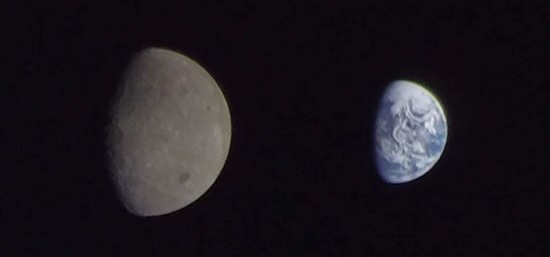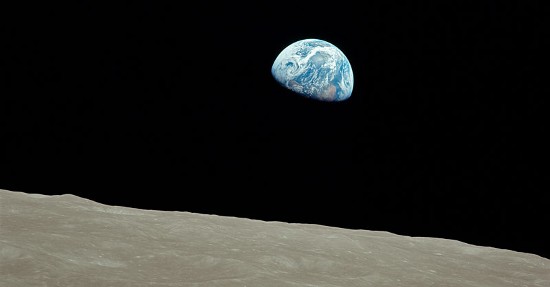The Artemis Program has many moving parts. We were introduced to the future crew of the Artemis 2 mission in the last week. Artemis 2 is a more sophisticated version of the Apollo 8 mission of 1968. Its sex appeal comes from the fact that the Orion spaceship will travel past the Moon for several thousand kilometres to create a photo-op of the Moon and Earth. It will then loop back to splashdown in the ocean back here on Earth.
Apollo 8 in December of 1968 gave us the above picture known as Earth Rise. Now we will add another inspiring picture of our pale blue planet as seen from far away with the Moon in the foreground. We’ve already seen a similar shot (see below) taken by Orion on the Artemis 1 mission in November of 2022. The big difference this time will be a human crew onboard.
 It’s nice, but forgive me if I don’t get too excited about what essentially will be a déjà vu moment. Yes, the Orion will be put through its paces over ten days with the testing of its habitability and other systems. But we’ve already seen the picture.
It’s nice, but forgive me if I don’t get too excited about what essentially will be a déjà vu moment. Yes, the Orion will be put through its paces over ten days with the testing of its habitability and other systems. But we’ve already seen the picture.
The real excitement begins with Artemis 3, currently scheduled for launch in December 2025. It is the first of many missions to establish a permanent habitat on the lunar surface. But building a permanent lunar base will need more than just astronauts toting and hauling stuff on the lunar surface. That’s where autonomous and semi-autonomous vehicles and robots will come into play.
FLEX is one of those. The name is an acronym meaning the Flexible Logistics and Exploration Rover. In the picture at the beginning of this posting, you can see FLEX in the foreground. It is being put through its paces in the California desert before deployment to the Moon and will get there carried on a SpaceX Starship scheduled to land there in 2026.
FLEX is being developed by Venturi Astrolab, a Monaco-based company. As the rover’s name suggests, it can serve as a multipurpose vehicle that features:
- The size equivalent of a large off-road vehicle on Earth with equal ruggidness.
- An ability to carry up to two tons of payload.
- Multiple reconfigurability either for hauling freight, for carrying two astronauts riding on the back or for reconnoitering the lunar surface to do science.
- Onboard navigation and hazard detection sensors for semi-autonomous operation.
- A very flexible robotic arm that can be used to support scientific research and investigations, or provide logistical support.
- Four-wheel articulated adaptive suspension designed to deal with the vagaries and unevenness of lunar terrain.
- Deployable and flexible solar panels that can be oriented to follow the Sun to maximize energy gathering to feed its onboard batteries.
- An interface to allow for remote teleoperators to control it from as far away as Earth, from lunar orbit, or by astronauts outside or in a future habitat.
- An ability to operate at temperatures between -90 and -230 Celsius, (-130 and -382 Fahrenheit), to withstand continuous solar and cosmic radiation, and to survive two weeks of the lunar night to which it could be subjected on missions near the Artemis’ chosen sites at the Moon’s South Pole.
NASA hasn’t yet announced its first choice in the current Lunar Terrain Vehicle competition, but it certainly is in the running. And with FLEX having been given the green light by SpaceX for its upcoming first commercial lunar cargo mission, the rover should have NASA’s eyes on it.
Astrolab, the inventor of FLEX is just one of a small group of companies that could become significant contributors to humanity going back to the Moon and later to Mars. Astrolab’s CEO, Gildo Pastor, in a recent interview with the Monaco Tribune described what he hopes will be “a place in the history books” having a rover that “will be the biggest and most powerful to ever have been sent to the Moon.”








